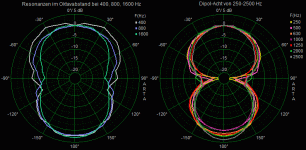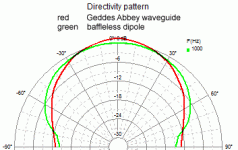You should work for the BBC 😀
Who, me? Perhaps I should work on my "OYE!"
I once measured such a U frame:Do cabinets have to be sonic black holes? Maybe if that woofer in a U-Frame is 3db down at some point, the baffle could be trained with bolts or materials to resonate a little where we want?

At the right is the typical figure 8 of the dipole. On the left I have extracted the response at 400, 800 and 1600 Hz. I attribute the increased radiation to resonating side panels. Possibly it could be made to resonate at the frequency we want. But it could not be made to resonate in the proper direction too. 😉
Rudolf
Possibly it could be made to resonate at the frequency we want. But it could not be made to resonate in the proper direction too. 😉
Rudolf
Bah, direction shmirection....lol.
I see what you're saying though.
Who, me? Perhaps I should work on my "OYE!"
I was referring to the thin wall cabinet design. 🙂
http://www.diyaudio.com/forums/multi-way/194452-bbc-thin-wall-enclosure-ported.html
Speaker Dave- I didn't keep the de-coupling in my experiment (or in my current speakers) because, while it significantly reduced the transmission of vibration into the cabinet, I heard no real improvement in sound quality at my listening position (I was disappointed) and because it really is tricky to achieve effective de-coupling with an 8" or 10" driver.
Now, before others ponder the point, I should point out that this did NOT mean that I concluded that, in general, vibrating cabinet panels are not audible. That conclusion is easily disproven, and Howard and Matthews' BBC research paper does so, as well as making a useful contribution on the thresholds of audibility of panel radiation. It's a little gem of a paper.
Rather, for the driver and cabinet that I was playing with, the result indicated that the problems that I was perceiving with sound quality were not directly due to the driver exciting the cabinet, since I'd slugged the driver/cabinet interface with heavy-duty damped de-coupling.
Was adding constrained layer damping 'gilding the lily'? Probably. And, judging by how quiet the panels remained after coupling the driver back to the cabinet, constrained layer damping appears to be quite effective. It's also easier to implement than de-coupling (!!!) but, beware, it's practically irreversible (my amateur experiment was ... amateur).
Bigun - you asked about the foam wedges. They're not so easy to make (a hot wire cutter is required - nichrome wire, a wooden frame and a battery will do the trick). For subsequent attempts, I've instead made cardboard triangular prisms and covered them with adhesive-backed felt and attched them to the basket arms.
Bondini
Now, before others ponder the point, I should point out that this did NOT mean that I concluded that, in general, vibrating cabinet panels are not audible. That conclusion is easily disproven, and Howard and Matthews' BBC research paper does so, as well as making a useful contribution on the thresholds of audibility of panel radiation. It's a little gem of a paper.
Rather, for the driver and cabinet that I was playing with, the result indicated that the problems that I was perceiving with sound quality were not directly due to the driver exciting the cabinet, since I'd slugged the driver/cabinet interface with heavy-duty damped de-coupling.
Was adding constrained layer damping 'gilding the lily'? Probably. And, judging by how quiet the panels remained after coupling the driver back to the cabinet, constrained layer damping appears to be quite effective. It's also easier to implement than de-coupling (!!!) but, beware, it's practically irreversible (my amateur experiment was ... amateur).
Bigun - you asked about the foam wedges. They're not so easy to make (a hot wire cutter is required - nichrome wire, a wooden frame and a battery will do the trick). For subsequent attempts, I've instead made cardboard triangular prisms and covered them with adhesive-backed felt and attched them to the basket arms.
Bondini
I once measured such a U frame:
View attachment 292438
At the right is the typical figure 8 of the dipole. On the left I have extracted the response at 400, 800 and 1600 Hz. I attribute the increased radiation to resonating side panels. Possibly it could be made to resonate at the frequency we want. But it could not be made to resonate in the proper direction too. 😉
Rudolf
That really is quite interesting to see, the increased output that is, as frequency rises. If it is the panels resonating I think it might more be a case of the entire cabinet being shaken rather then a resonance as per say, although I don't know why that effect would go away as frequency decreases. It could of course be a lowish Q broader-band effect.
Foam on basket arms
TMHutson - I changed from foam on the baskets to cardboard triangular prisms covered with adhesive felt, which was also useful for attaching the structure to the basket. I opted for prisms to deflect incident waves since, as you correctly point out, the foam layer was thin and hardly optimal, plus the foam was hard to handle. Regardless, the main effect I perceived was in cleaning up 'nasal' tones in voice and singing.
Ideally, the basket would be a fine structure with thin arms. In practice, this is not a simple thing to achieve without significantly increasing the cost of making the basket.
The more important application of foam was on the cabinet behind and adjacent to the rear of the driver. This 'cleaned up' every tone down to the mid-bass (my perception).
Yes, I have concentrated on full-range drivers, as they are my personal interest. I think careful cheap experiments on other driver and cabinet configurations may offer further insights, though I'm loath to generalise my results or, indeed, anyone else's unless the experiment is better designed than my own!
Bondini
TMHutson - I changed from foam on the baskets to cardboard triangular prisms covered with adhesive felt, which was also useful for attaching the structure to the basket. I opted for prisms to deflect incident waves since, as you correctly point out, the foam layer was thin and hardly optimal, plus the foam was hard to handle. Regardless, the main effect I perceived was in cleaning up 'nasal' tones in voice and singing.
Ideally, the basket would be a fine structure with thin arms. In practice, this is not a simple thing to achieve without significantly increasing the cost of making the basket.
The more important application of foam was on the cabinet behind and adjacent to the rear of the driver. This 'cleaned up' every tone down to the mid-bass (my perception).
Yes, I have concentrated on full-range drivers, as they are my personal interest. I think careful cheap experiments on other driver and cabinet configurations may offer further insights, though I'm loath to generalise my results or, indeed, anyone else's unless the experiment is better designed than my own!
Bondini
Not sure what you mean by that ?
They are fairly dense rockwool covered with some kind of fabric on one side. I used the "natural" type, where the fabric is not painted. The surface looks greenish ... It also comes in white and black paint, but the paint reduces the good acoustical properties unfortunately.
So they are dense and laminated. No wonder you get reflections.
Yes of course.
The challenge is to find something that can hold back the rockrool dust, and still not hold back sound waves. It has to be a compromize.
No, as David already pointed out there's fabric that will hold back the fibers but not the sound waves.
they like the reflected sound ambience (i.e. nothing to do with box colourations per se)
That's the most likely explanation.
Certainly you are talking about the larger reverberation distance made possible by less reflected sound from the dipole (compared to monopole). 😉That's the most likely explanation.
Rudolf
Certainly you are talking about the larger reverberation distance made possible by less reflected sound from the dipole (compared to monopole). 😉
Rudolf
No, because in my mind that 4.8dB figure is just a theoretical construct. It ignores the first reflection pattern in a room which is key to what is perceived in terms of spaciousness.
I dont agree. I have measured the ETC in several rooms with both dipoles and monopoles, and there is no doubt that the level of reflections and reverb is lower with a dipole. If a dipole with constant directivity is toed-in properly, first reflection of both front wall and nearest side wall is more or less eliminated.
I dont agree. I have measured the ETC in several rooms with both dipoles and monopoles, and there is no doubt that the level of reflections and reverb is lower with a dipole. If a dipole with constant directivity is toed-in properly, first reflection of both front wall and nearest side wall is more or less eliminated.
"Monopoles" is also just a theoretical construct at higher frequencies where reflections matter and where an ETC has its value. Measure a waveguide speaker instead.
By the way, who says that the level of (certain) reflections (especially from the sides) needs to be lower to sound "better"?
Last time I compared with yours, I found my ETCs no worse than yours. 😀"Monopoles" is also just a theoretical construct at higher frequencies where reflections matter and where an ETC has its value.
Measure a waveguide speaker instead.

Doesn't look that much different. I agree that my dipoles have the same radiation pattern to the back too.
Fine. Now that we have agreed that dipoles don't radiate more but less than monopoles, the different PATTERN comes into view. Funny that this hasn't come up earlier in this thread.By the way, who says that the level of (certain) reflections (especially from the sides) needs to be lower to sound "better"?
Rudolf
Funny that this hasn't come up earlier in this thread.
I joined late 😉 On the other hand, there's not much objective data suggesting what would be "best" in terms of reflections so people keep discussing secondary topics.
Last edited:
Last time I compared with yours, I found my ETCs no worse than yours. 😀
Now let's compare other performance factors like distortion and max. SPL 😛
"Monopoles" is also just a theoretical construct at higher frequencies where reflections matter and where an ETC has its value. Measure a waveguide speaker instead.
By the way, who says that the level of (certain) reflections (especially from the sides) needs to be lower to sound "better"?
Maybe I should have been more spesific... I meant "small two-way stand-mount bookshelf speakers with dome tweeters".
Yes, good waveguide speakers are far better behaved in this respect. No wonder waveguides are popular.
Personally I think all kinds of reflections are coloring the sound, not just what happens within the speaker, but certainly also room reflections. I dont like what they do to the sound, and I do what I can to get rid of them.
Maybe I should have been more spesific... I meant "small two-way stand-mount bookshelf speakers with dome tweeters".
Well, that's certainly NOT a monopole 🙂
Personally I think all kinds of reflections are coloring the sound, not just what happens within the speaker, but certainly also room reflections. I dont like what they do to the sound, and I do what I can to get rid of them.
Yes, they do "color" the sound but they are also responsible for spaciousness. A violin in a room sounds different ("colored") when compared to a violin played outside. This is a topic where we unfortunately don't have good answers yet. Of course the audiophool inquisition has answers.
- Home
- Loudspeakers
- Multi-Way
- Box colourations - really ?